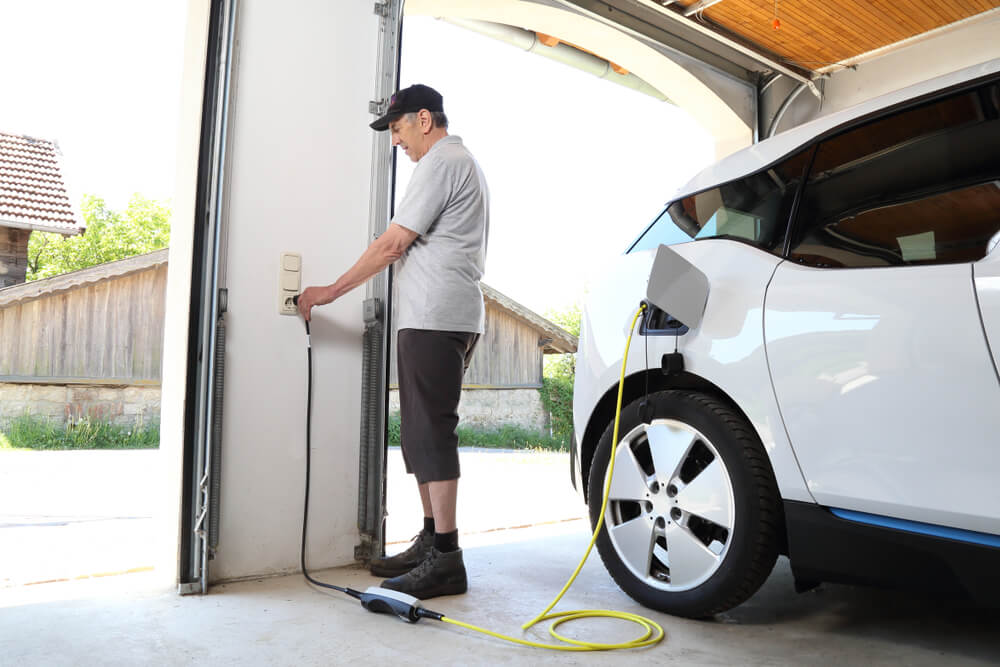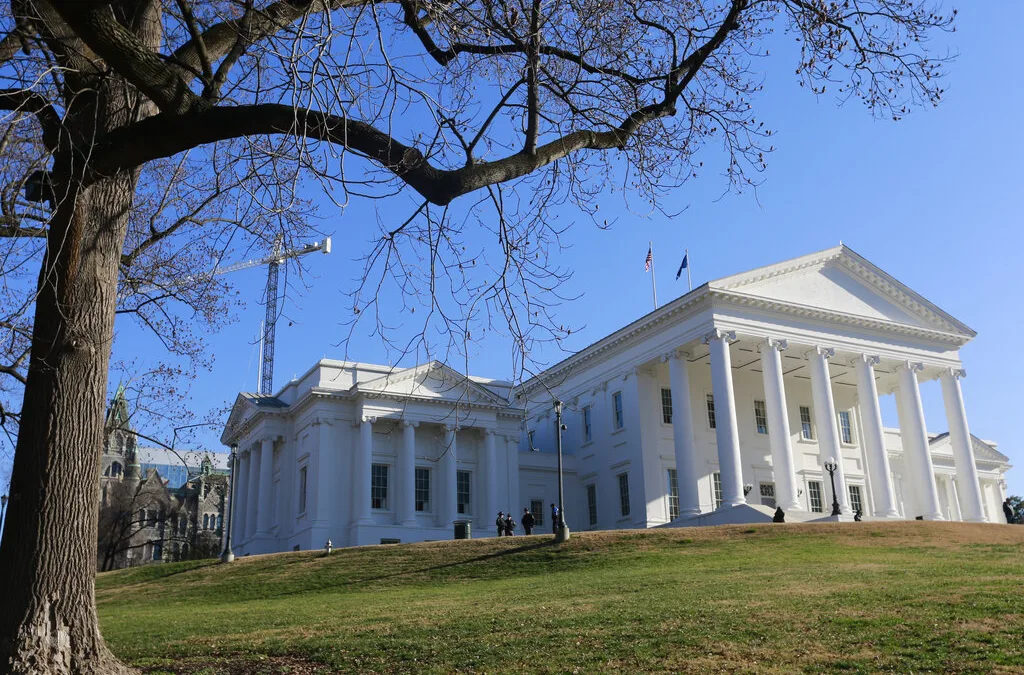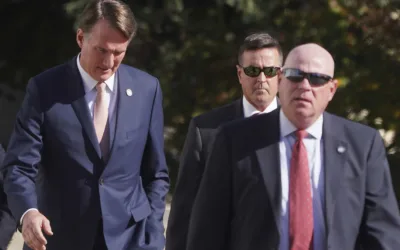
Image via Shutterstock
Electric cars are cheaper to maintain, too; they only have about 20 moving parts compared to 2,000 for gas-powered engines.
Whether you live in Northern Virginia or Norfolk, chances are you’ve found yourself paying more than usual for gas these past few months. It’s probably made your daily bouts with traffic more stressful too, knowing you’re burning precious dollars on your stop-and-start commute.
But what if you never had to worry about rising gas prices—and all you needed to do was plug your car in while you sleep to have the equivalent of a full tank of gas the next morning?
That’s Norfolk resident Ruth McElroy Amundsen’s experience—and that of thousands of other Virginians.
Amundsen, an aerospace engineer at NASA, is the proud owner of two electric cars—a 2014 BMW i3 and a Tesla Model S—as well as a plug-in hybrid. She can barely hide her excitement when she talks about the benefits and convenience of electric vehicles (EVs).
“I absolutely love it,” the 59-year-old told Dogwood. “I don’t have to keep track of who’s selling gas the cheapest, I don’t have to worry about whether there’s a run on gas stations and I don’t have to worry about going and filling up before a hurricane. You can just completely ignore that entire set of worries.”
It also means more cash in your pocket. “When gas goes up to $4 a gallon, having an electric car that’s charging at a penny per mile looks even better,” Amundsen—who also runs side businesses involved in solar energy—said. The cost to charge EVs varies slightly based on what kind of car and charger you have, where you live, and how much demand there is on the power grid. In any case though, it’s still a lot cheaper than gas.

The average Virginian spends more than $1,100 a year on fuel. As consumers deal with the headache of rising gas prices—driven by greedy oil companies making record-breaking profits—it may be reassuring to know that the sorts of savings Amundsen enjoys could be coming for a majority of residents within the next 10 to 20 years. Every major automaker in the US is building out its EV brand—with many planning on only selling EVs after certain dates.
The impact of EVs cannot be overstated.
The ability to charge a vehicle overnight for about a dollar a gallon, said Alleyn Harned, executive director of Virginia Clean Cities, will lead to a “fundamental shift in people’s budgets as we would essentially give Americans a raise by letting them keep that fuel energy in their pockets.”
The typical car owner in Virginia would save nearly $800 each year on fuel costs, while SUV and pick-up owners would save more than $1,000 a year, according to Consumer Reports.
How quickly we get to that future remains to be seen; even as there’s been a global surge in EV sales this year, the United States lags behind China and Europe in terms of uptake.
That may change though. President Joe Biden’s newly signed infrastructure law will invest at least $106 million to expand EV charging networks across Virginia in order to make it easier to charge electric cars in public. The real game-changer is what’s on deck, though: If Democrats succeed in passing the Build Back Better Act—a widely popular bill with zero Republican support—the sale price of many EVs would be slashed by up to $12,500 at the point of sale, making them a far more appealing option for working- and middle-class Virginians.
Such a policy would not only help would-be EV consumers save money on cars, maintenance, and fuel, but it could also theoretically reduce the costs of gas for other drivers by reducing demand. So if you want a future without $3.50-a-gallon gas, EVs provide the path to get there.
There’s a long way to go on that path, though. As of December 2020, there were 20,520 battery electric vehicles and another 11,000 plug-in hybrid EVs registered in Virginia, representing just a fraction of the more than 8.3 million vehicle registrations in the commonwealth.
“In the United States, certainly we’re at the very beginning” of the transition to EVs, said Elgie Holstein, senior director for strategic planning at the Environmental Defense Fund.
But with each passing year, EVs are going more and more mainstream. From June 2020 to June 2021, electric car registrations grew by 44%, according to the Virginia Department of Motor Vehicles. The EV revolution is happening. All that remains to be seen is how quickly the transition happens and whether the US leads the way—as Biden is trying to do—or cedes ground to Europe and China, missing out on jobs and economic prosperity in the process.
“This is an opportunity for the rebirth of American leadership in vehicle technology,” Holstein said. “This is a fundamental change in our transportation technology that benefits consumers, as well as the environment, and I think that’s a unique and very positive selling proposition and one that has the prospect of creating thousands of new jobs for American workers.”
‘Electric Cars Just Make Life Very Easy’: The Perks of EV Ownership
When Amundsen bought her BMW i3 in 2015, she did so because the car’s 90-mile range fit within her lifestyle: She could commute to work as needed, run errands, and charge at home each night without an issue. She also wanted to do her part to fight climate change.
Emissions from gas-powered vehicles are a leading cause of climate change, which has increased the likelihood of heat waves, floods, and hurricanes in the commonwealth. To be clear, EVs are not some cure-all for the climate crisis; they can still put a strain on the electric grid and some electricity comes from fossil-fuel power plants. But on the whole, they represent a real step forward in making the US less reliant on fossil fuels.
For Amundsen, going electric was feasible because the car was reasonably priced for her budget. She paid $34,000 for the i3, but received the $7,500 tax credit that applies to EV sales, bringing down the actual price to $27,500.
Six years after her first purchase, she is a hardcore EV enthusiast. Amundsen has not only saved money on gas, but also maintenance. Because of the simplicity of electric engines—they have about 20 moving parts compared to 2,000 for gas-powered engines—electric cars are easier and cheaper to maintain.
“We don’t have to get oil changes or transmission fluid. All of the maintenance stuff is incredibly easy. There’s really nothing to do other than put windshield wiper fluid in the car,” Amundsen said. “The electric cars just make life very easy.”
EV owners spend about half as much on maintenance and repairs over the life of a vehicle compared to owners of gas-powered cars, amounting to a savings of $4,600, according to Consumer Reports.
Charles Gerena’s experience with EVs has also been positive. The lead organizer of Drive Electric RVA, a community of EV owners in Richmond, Gerena purchased a Nissan Leaf in January 2014 and recently switched to a Chevy Bolt in March. The 52-year-old made the transition from gas to electric cars for both financial and environmental reasons.
With his last gas car, Gerena was spending over $100 a month on fuel, he said. His EVs, meanwhile, only add about $40 to $50 a month to his electric bill. “I know what impact it’s going to have and that’s a lot less fluctuation than average gas prices,” Gerena said.
Initially, Gerena was worried that EVs would be more like “electric golf carts” than real cars, but a test drive showed him that they drive just like regular cars, only quieter. “I was really surprised at the acceleration, the responsiveness of the car … and I was hooked on it.”
Amundsen similarly raved about the performance of EVs: “They’re just really fun to drive.”
The Societal Benefits of EVs
The benefits of EVs to individual consumers are significant, but the society-wide implications are even greater. According to a recent report from Generation 180, a Charlottesville-based nonprofit, transitioning to more EVs would improve public health, reduce personal transportation emissions by up to 70%, and could create an estimated 2 million jobs across the US. Widespread adoption of EVs would also keep more of the money Virginians spend on energy in state and make the American economy more resilient in the face of fluctuating oil prices.
“One of the promises of electric vehicles is that we really do begin to make the American driver less of a hostage to international oil pricing intrigue,” Holstein said. “That’s not something that happens overnight, but certainly with every passing year as you sell more and more EVs, you do lower demand and so you’re taking more and more consumers out of the bidding pool for the available supplies of gasoline.”
But if EVs are so great, why is it taking so long for people to transition to them?
High Prices and Lack of Availability Are a Problem
Upfront cost and lack of inventory are two barriers. The average sale price for an EV in October 2021 was $55,676, roughly $13,000 higher than what you’d pay for a full-size gas car and $30,000 more than the average sale price for a compact car, according to Kelley Blue Book. (The average price of EVs was under $50,000 as recently as June, but has temporarily increased due to supply chain issues.)
There is good news though: EV prices have declined over time, and a used EV market has developed, providing middle-class consumers with a more viable pathway into this space.
On the inventory front, Gov. Ralph Northam this year signed a new law directing Virginia to adopt California’s stricter vehicle emissions standards by 2025 while also requiring that a certain percentage of all cars sold in the state be either electric or hybrid by then. The measure will help spur greater availability of EVs in Virginia, as will market forces that are already trending in that direction; production is expected to surge over the next decade.
“If we start really mass producing electric vehicles of all sizes and shapes then the retail prices should fall,” said Mike Ellerbrock, a professor of economics at Virginia Tech University.
In fact, industry experts predict that brand-new EVs could be cheaper than gas-powered cars as soon as 2025. That leaves charging infrastructure as the largest remaining hurdle.
Virginia’s Charging Infrastructure Is Ramping Up, But There’s a Long Way to Go
Virginia currently has about 2,600 publicly available charging plugs, according to the Department of Energy’s Advanced Fuels Data Center. In contrast, there are about 4,500 gas stations—and exponentially more pumps—across the commonwealth, according to Harned.
While the majority of EV owners, including Amundsen of Norfolk, have home charging stations, some rely on those that are publicly available. This difference in availability matters; some consumers opt against EVs because they’re worried that the reduced mile range of EVs and the limited charging infrastructure could leave them stranded, or at the very least make longer drives or road trips a hassle
This “range anxiety” has been a major roadblock to EV uptake, but the median range of EVs for sale in the US is now 250 miles per full charge. While gas vehicles still hold an edge, the gap is narrowing rapidly, and EVs with ranges of up to 500 miles are on their way to market.
Virginia’s public charging infrastructure has also expanded each year, and continues to improve. Gerena, the EV owner in Richmond, recounted how he and his family take an annual road trip to North Carolina. For most of the past decade, traveling via EV wasn’t an option because there wasn’t enough charging infrastructure along the route. But he said he was thrilled to see many more had been installed recently.
“I can actually make this work because those gaps have been filled in,” Gerena said. “While I might have to stop maybe one or two more times than I normally would in a gas car, it’s actually now a practical trip to make because of that infrastructure being filled in.”
Still, the commonwealth has a long way to go and needs to add tens and possibly hundreds of thousands of chargers to support widespread EV usage.
Biden’s Investment in EV Chargers Is a ‘Game-Changing Opportunity’
Helpfully, funding to build out more chargers is on the way, thanks to the new infrastructure law championed by President Biden. The law will invest at least $106 million to expand the number of public charging stations in Virginia. Under the law, the commonwealth will also have the chance to apply for $2.5 billion in grant funding dedicated to EV charging.
“The investment is a game-changing opportunity for states and communities to set forward significant and robust electric charging networks,” Harned said.
It’s unclear exactly how many stations that will fund, but Harned expects it to help the state install between “thousands” and “tens of thousands” of new charging stations.
Biden’s Build Back Better Plan Would Save Consumers A Fortune on American-Made, Union-Built EVs
While building out America’s charging infrastructure is imperative, so too is making EVs themselves more affordable. Biden knows this, which is why his Build Back Better Act—which has passed the US House and is currently being negotiated in the Senate—would improve upon the existing $7,500 incentive to buy an EV.
Currently, EV buyers pay the full purchase price up front and then get the rebate when they file their taxes. The Build Back Better Act would increase incentives to a maximum of $12,500 and allow dealers to apply them at the point of sale. The upfront nature of the rebates is a huge deal, according to Harned.
“Americans like to purchase vehicles and sort of walk out and understand their costs, and the previous incentive was confusing enough that dealers and consumers weren’t always aware of what was offered to them,” he said. “Having a dealer-centric incentive is a great idea to make better use of the same amount of money, make better use of the incentive.”
The specifics of the proposal could still change during negotiations, but here’s what the current bill would give consumers:
- a $7,500 rebate for an EV or plug-in hybrid with battery capacity at least 40 kilo-watt hours (kWH) and a gas tank, if any, of under 2.5 gallons. After 2027, the rebate would only apply to American-made vehicles with a battery of at least 50 kWH.
- a $4,500 credit for cars assembled at a unionized US plant.
- a $500 credit for EVs with a battery pack made in the US.
In a big change, the $7,500 rebate would also apply to Teslas and Chevys, the most popular EV brands. Under current law, consumer credits phase out after carmakers sell more than 200,000 qualifying vehicles—a threshold both companies crossed in recent years.
While the rebate would apply to a lot of EV sales, it won’t cover every car or every buyer:
- vans, SUVs, and pick-up trucks need to be under $80,000 to be eligible for the credit, while all other cars need to be priced at $55,000 or less.
- married couples earning over $500,000 and individuals earning over $250,000 won’t qualify for the credits.
In other words: these credits will help middle-class and upper middle-class Americans buy reasonably priced EVs rather than help the wealthy buy luxurious playthings.
Ellerbrock, the Virginia Tech economics professor, believes these figures could make a real difference in convincing hesitant Americans to buy EVs. “To a middle-class consumer, these numbers and dollars we are discussing, I think they’re pretty substantial,” he said.
Finally, Biden’s bill would also make used EVs eligible for credits of up to $4,000 and provide a credit for electric motorcycles or three-wheeled vehicles, up to $7,500 or half the machine’s price.
Holstein praised Biden’s infrastructure law, but made clear that the Build Back Better Act was just as critical for a wide-scale transition to EVs. “We need both steps,” he said.

Here’s everything you need to know about this month’s Mercury retrograde
Does everything in your life feel a little more chaotic than usual? Or do you feel like misunderstandings are cropping up more frequently than they...

VIDEO: Check out Dogwood’s new merch line
Big news, Virginia! We've officially launched our Dogwood merch line 🎉 This year, we celebrate 5 years of bringing you Virginia news you can use....

VIDEO: Your support matters!
Your support matters! Donate today. @vadogwoodnews Your support matters! Visit our link in bio to donate today. #virginianews #virginia #community...

Op-Ed: Virginia’s new Democratic majorities pass key bills to improve your lives, but will Youngkin sign them?
The 2024 Virginia General Assembly regular session has wrapped up. It was a peculiar session from the outset, with Democratic majorities in the...

From the state rock to the state flower, here’s how Virginia got its symbols
Have you ever wondered why the Dogwood is the state flower? Or how the cardinal became the state bird? We’re here to answer those questions and more...

VIDEO: Second-gentleman Douglas Emhoff gives speech on reproductive freedom
Second gentleman, Douglas Emhoff touched on reproductive freedom not only being a woman's issue but "an everyone's issue" during the Biden-Harris...




